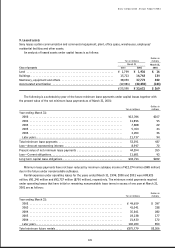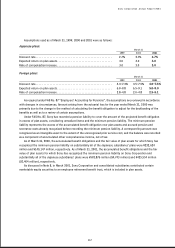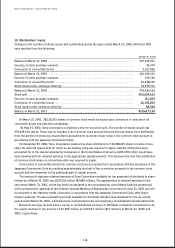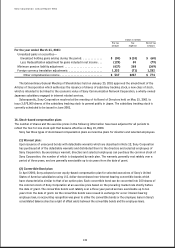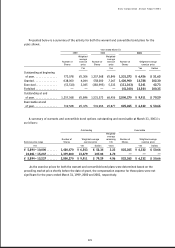Sony 2001 Annual Report Download - page 115
Download and view the complete annual report
Please find page 115 of the 2001 Sony annual report below. You can navigate through the pages in the report by either clicking on the pages listed below, or by using the keyword search tool below to find specific information within the annual report.
Sony Corporation Annual Report 2001
113
At March 31, 2001, Sony had unused committed lines of credit amounting to ¥474,879 million ($3,799 million)
and can borrow up to generally 90 days from the banks with whom Sony has committed line contracts. Furthermore,
Sony has Commercial Paper Programs, the size of which was ¥1,252,425 million ($10,019 million). At March 31,
2001, the total outstanding balance of commercial paper was ¥117,295 million ($938 million). In the United States
of America, Sony set up a ¥111,510 million ($892 million) accounts receivable financing facility to enhance its
short-term financing capacity. Under those programs and the facility, Sony can issue commercial paper and sell
receivables for the period not in excess of generally 270 days up to the size of the programs and the facility. In
addition, for non-current financing purposes, Sony has Medium Term Notes programs, the size of which was
¥805,350 million ($6,443 million). At March 31, 2001, the total outstanding balance of Medium Term Notes was
¥79,296 million ($634 million).
The basic agreements with certain banks in Japan include provisions that collateral (including sums on deposit
with such banks) or guarantors will be furnished upon the banks’ request and that any collateral furnished, pursuant
to such agreements or otherwise, will be applicable to all present or future indebtedness to such banks.
13. Financial instruments
Sony has certain financial instruments including financial assets and liabilities and off-balance-sheet financial instru-
ments incurred in the normal course of business. In applying a consistent risk management strategy, Sony manages
the exposure to market rate movements of its financial assets and liabilities through the use of derivative financial
instruments which include foreign exchange forward contracts, foreign currency option contracts, interest rate swap
agreements and interest rate and currency swap agreements designated as hedges. These instruments are executed
with creditworthy financial institutions, and virtually all foreign currency contracts are denominated in U.S. dollars,
euros and other currencies of major countries. Although Sony may be exposed to losses in the event of nonperfor-
mance by counterparties or interest and currency rate movements, it does not anticipate significant losses due to
the nature of its counterparties or the hedging arrangements.
Following are explanatory notes regarding the financial assets and liabilities and off-balance-sheet financial
instruments.
(1) Cash and cash equivalents and time deposits:
In the normal course of business, substantially all cash and cash equivalents and time deposits are highly liquid
and are carried at amounts which approximate fair value.
(2) Short-term borrowings and long-term debt:
The fair values of short-term borrowings and total long-term debt, including the current portion, were
estimated based on either the market value or the discounted amounts of future cash flows using Sony’s
current incremental borrowing rates for similar liabilities.
(3) Derivative financial instruments:
Sony utilizes foreign exchange forward contracts and foreign currency option contracts primarily to fix the cash
flow value resulting from inter-company accounts receivable and payable and future transactions denominated
in foreign currencies in relation to the core currencies (Japanese yen, U.S. dollars and euros) of Sony’s major
operating units.
Sony has entered into foreign exchange forward contracts in the contracted amounts of ¥822,644 million
and ¥1,189,710 million ($9,518 million) at March 31, 2000 and 2001, respectively. The majority of these contracts
mature within four months. The fair values of these contracts were estimated based on market quotations.








